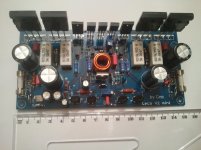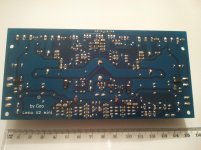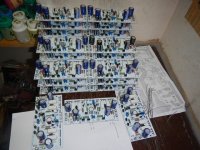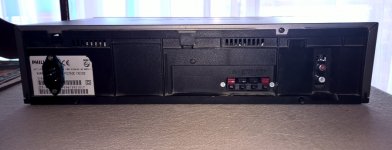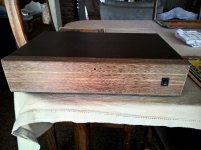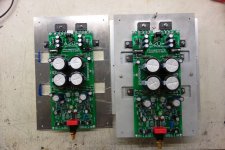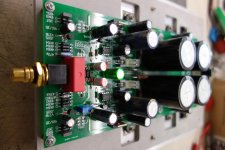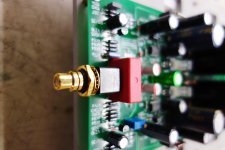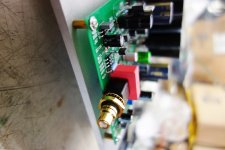A Simple Fully Symmetrical Sound Amplifier
Sells only in Romania or worldwide?
Sells only in Romania or worldwide?
Those (blue ones) are not for sale
Are only for the joy of eyes and ears
Those (blue ones) are not for sale
Are only for the joy of eyes and ears
And what about the white ones?
Attachments
And what about the white ones?
Not my concern
Here is the link with the performance...since you asked:
http://www.forum.poweraudio.ro/viewtopic.php?f=64&t=23054&sid=f68906746f6a3bfd2b1a7cd9521b7029
Last edited:
Member
Joined 2009
Paid Member
First time I saw use of crowbar speaker protection on-board a power amp.
It also has shortcircuit protection. Tested accidentally today. I thought that the speaker is connected when in fact the wires where under the furniture and they where shorted.
I finally found an old VHS machine to strip out and house my amplifier. This amplifier is very good, especially in terms of noise. It has very low noise, and no hum visible on a scope or audible. I like it.  The plan is to use this for PA. I just need to clean up the chassis a bit.
The plan is to use this for PA. I just need to clean up the chassis a bit.
Attachments
In those very small signal circuits, often the noise comes more from the resistors or some other passive parts rather than the opamps. The very low noise opamps can make for very nice performance but then most of the noise is not coming from them.
So using low noise resistors can really help with that, and I've been looking into this because I've been working for some time on my design of an active filter for multi-amp and while trying to make choices, I find that for best noise figures, perhaps the metal foil resistors would be the better choice.
I know it's straying a bit from the main topic on this thread, but it's somewhat related.
I have not found threads about active crossover design, and I've been thinking perhaps a new thread could be started.
My plan is for a 4 way filter, with a few bells and whistles like a limiter on each output, a muting and a few other things like that.
So using low noise resistors can really help with that, and I've been looking into this because I've been working for some time on my design of an active filter for multi-amp and while trying to make choices, I find that for best noise figures, perhaps the metal foil resistors would be the better choice.
I know it's straying a bit from the main topic on this thread, but it's somewhat related.
I have not found threads about active crossover design, and I've been thinking perhaps a new thread could be started.
My plan is for a 4 way filter, with a few bells and whistles like a limiter on each output, a muting and a few other things like that.
There are many Threads dedicated to designing active filters.
Some are from nearly a decade ago.
There were at least three that had very detailed design discussion with lots of filter and EQ graphs and included PCBs.
I have not found (yet) anything that corresponds to what I'm aiming to do.
Perhaps it might be good to have links to those threads in here, to make it easy.
I found that thread about that ACD tool, which has interesting features, especially being a spreadsheet, it's not tied to any specific computer platform, but unfortunately, unless I'm really missing something, it doesn't pertain to the type of design I'm contemplating.
For reference, here's a link to an external site with useful info:
Active Filters
This is more in line with my goal, but there is more to it.
I'm aiming at 4 ways, using the topology with the phase correction introduced by using all-pass sections with the subsequent substraction, before going on to the next band...
The type of filter would be linkwitz-riley with 24db/oct roll-off.
I will have a symetric input, with a detection of modulation signal to feed to a microcontroller that will handle most things, such as gentle power-ups of all the amps, muting, and turning off all power when the system isn't in use for a little while, with re-power-up when a signal is coming in, with no human action at all.
Active Filters
This is more in line with my goal, but there is more to it.
I'm aiming at 4 ways, using the topology with the phase correction introduced by using all-pass sections with the subsequent substraction, before going on to the next band...
The type of filter would be linkwitz-riley with 24db/oct roll-off.
I will have a symetric input, with a detection of modulation signal to feed to a microcontroller that will handle most things, such as gentle power-ups of all the amps, muting, and turning off all power when the system isn't in use for a little while, with re-power-up when a signal is coming in, with no human action at all.
Is it ok to revive an old thread that's been basically abandoned for years and more or less "hijack" it with new contents?
http://www.diyaudio.com/forums/multi-way/189386-4-way-active-system.html
That thread is right on the subject that I want to address, and it's been dead for years now.
What was discussed in that thread was not quite what I'm looking to do. Although as the thread title says, it's a 4 ways active system being sought, but what I'm after differs quite a bit.
I'm not at all looking at DSP or anything digital, only all analog filters.
I'm not looking to make any use of ready made devices from the market, but to design and build everything, including the power amps and speakers.
Actually I already have my speakers, so I am shooting for filters with cut-off frequencies chosen for those existing speakers.
So to summarize: what I'm looking to design is a 4 way linkwitz-riley 24db/oct, with the all-pass phase compensation on each band, to keep phase correct among all bands.
My filters being planned to be in the same chassis as all the power amps, the coupling between them would be well defined and should avoid too many coupling caps.
As I mentioned, a microcontroler would control everything, so things like muting switches and power controls would be built-in.
I considered hiving the choice of cut-off frequencies, but this seems far too complicated with too many switches.
All switches would be solid state only, including those for the power amps output relays and rails.
http://www.diyaudio.com/forums/multi-way/189386-4-way-active-system.html
That thread is right on the subject that I want to address, and it's been dead for years now.
What was discussed in that thread was not quite what I'm looking to do. Although as the thread title says, it's a 4 ways active system being sought, but what I'm after differs quite a bit.
I'm not at all looking at DSP or anything digital, only all analog filters.
I'm not looking to make any use of ready made devices from the market, but to design and build everything, including the power amps and speakers.
Actually I already have my speakers, so I am shooting for filters with cut-off frequencies chosen for those existing speakers.
So to summarize: what I'm looking to design is a 4 way linkwitz-riley 24db/oct, with the all-pass phase compensation on each band, to keep phase correct among all bands.
My filters being planned to be in the same chassis as all the power amps, the coupling between them would be well defined and should avoid too many coupling caps.
As I mentioned, a microcontroler would control everything, so things like muting switches and power controls would be built-in.
I considered hiving the choice of cut-off frequencies, but this seems far too complicated with too many switches.
All switches would be solid state only, including those for the power amps output relays and rails.
- Home
- Amplifiers
- Solid State
- Post your Solid State pics here
